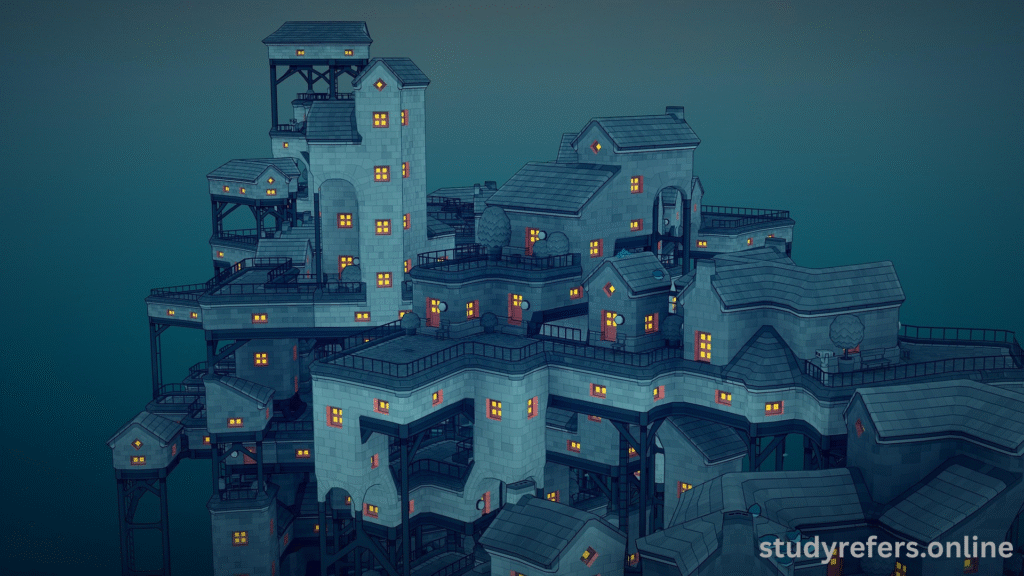Introduction to Drawing Technological Floating Islands
The idea of a technological floating island drawing brings to mind images of futuristic environments where the latest technology meets stunning imagination. Such drawings, commonly found in sci-fi movies, video games, and concept art, show gravity-bending islands driven by state-of-the-art technology, combining nature and innovation. For artists, the process of designing such drawings is both technical and artistic and involves finesse with digital tools, perspective, and futuristic design. This keyword-optimized blog post investigates the art, methods, sources of inspiration, and cultural values of “drawing of technological floating islands” and is an authoritative guide for artists and connoisseurs as of June 19, 2025.

What are Technological Floating Islands in Art?
Technological floating islands are creative renderings of landmasses floating above the ground, usually driven by high-tech machinery, anti-gravity technology, or other advanced power sources. The islands have glitzy metallic architecture, radiant energy centers, and thick forests, with technological and organic aspects integrated into them. Well-liked in science fiction films such as Avatar’s Pandora or Halo’s Forerunner realms, these concepts evoke wonder and curiosity. A sketch of technological floating islands usually depicts:
-
Futuristic Architecture: Platforms, towers, or holographic projections built into the islands.
-
Environmental Harmony: Nature existing alongside tech, representing green futures.
-
Dynamic Lighting: Bioluminescent plants, LED effects, or neon glows adding visual enhancement.
X users tend to upload such paintings, hailing its “otherworldly beauty” and “integration of nature and tech,” a sign of increased demand in online art communities.
Why Draw Technological Floating Islands?
1. Creative Expression
Creating technological floating islands provides artists with the scope to stretch creative horizons, envisioning utopian or dystopian realities. With the flexibility of creating special ecosystems and technologies, artistic creativity is stimulated.
2. Career Opportunities
Film, game, and animation studio concept artists usually create illustrations like these. Studios such as Industrial Light & Magic recruit artists with experience in futuristic landscapes, according to job postings on ArtStation.
3. Cultural Relevance
These illustrations strike a chord with viewers interested in futurism and sci-fi, echoing themes of high-tech development and sustainability. X posts illustrate their popularity, as one commentator said, “Floating island art feels like a glimpse into 2050.”
4. Technical Skill Development
Developing these illustrations skills digital art software, perspective, and light. Refining these skills boosts an artist’s portfolio, getting gaming and film clients.
Techniques for Drawing Technological Floating Islands
1. Concept Development
Begin with a strong vision. Your islands utopian or dystopian? Anti-gravity or quantum-powered? Scribble thumbnails to try out forms, such as jagged cliffs or smooth plates, as discussed in digital artwork tutorials.
2. Digital Tools
Use programs such as Adobe Photoshop, Procreate, or Blender for 2D and 3D modeling. The brush tools of Photoshop are best used for detailing metallic frameworks, while Blender does well in rendering 3D island models. A source suggests Clip Studio Paint for its “versatile sci-fi brushes.”
3. Perspective and Composition
Floating islands require strong perspective to convey depth. Use one- or two-point perspective to position islands in 3D space. Place larger islands in the foreground and smaller ones receding into the distance, as advised in concept art guides.
4. Lighting and Effects
Add glowing details, such as LED panels or energy cores, to highlight technology. Employ soft brushes for atmospheric shading, such as mist or clouds, to create the floating effect. DeviantArt tutorials highlight “dynamic lighting” for sci-fi realism.
5. Merging Nature and Technology
Include plants, waterfalls, or bioluminescent flora to set against clean tech features. This integration, such as in Avatar’s Hallelujah Mountains, produces visually dramatic designs, observed by X artists posting their work.
Inspirations for Drawing Floating Islands of Technology
1. Science Fiction Media
Movies such as Avatar and Guardians of the Galaxy depict floating landscapes with cutting-edge technology, inspiring artists. No Man’s Sky games display procedurally generated floating islands, engaging X in discussions on “infinite sci-fi worlds.”
2. Concept Art Communities
Sites such as ArtStation and DeviantArt feature collections of floating island artwork. Such artists as Raphael Lacoste, who has worked on Assassin’s Creed, post tips for sci-fi landscapes, inspiring young illustrators.
3. Real-World Technology
New technology, such as drone swarms or maglev trains, inspires anti-gravity theory. In 2025, the IEEE published a report on levitation technologies, which sparks ideas for realistic island mechanics, seen in X posts regarding “real-world sci-fi.”
4. Literature and Mythology
Novels such as Gulliver’s Travels (Laputa) or The Stormlight Archive (moving cities) lend themselves to narrative ideas. They integrate myth and technology, inspiring artists to design immersive worlds.
Tools and Resources for Artists
-
Software: Adobe Photoshop, Procreate, Blender, or Clip Studio Paint for digital painting.
-
Tablets: Wacom or iPad Pro for accurate drawing, recommended on X for “smooth workflow.”
-
Tutorials: YouTube channels such as Proko or ArtStation Learning provide courses on sci-fi concept art.
-
Brushes: Download sci-fi brush packs from Gumroad or DeviantArt for metallic textures and glowing effects.
-
Communities: Join Reddit’s r/conceptart or Discord servers for feedback and inspiration.
Cultural Impact of Technological Floating Island Art
The creation of futuristic floating islands has become a popular culture phenomenon, symbolizing mankind’s interest in futuristic utopias. The illustrations can be seen on blockbuster movies, AAA titles, and NFT platforms, fueling demand for experienced artists. On X, enthusiasts post fan art based on Avatar or Horizon Zero Dawn, with one user commenting, “These drawings make me dream of living in a floating city.”
The art form also sparks discussions about sustainability and technology’s role in shaping habitable environments, especially as climate change prompts interest in alternative living spaces. Exhibitions like SIGGRAPH 2025 showcase such illustrations, highlighting their influence on visual culture. While no major films focus solely on floating island art, their presence in sci-fi media suggests potential for future projects.
Challenges in Creating Technological Floating Island Art
1. Technical Complexity
Achieving perspective, lighting, and 3D rendering takes advanced skills. Newcomers can be overwhelmed by applications such as Blender, according to Reddit forums.
2. Balancing Realism and Imagination
One has to combine realistic technology with imaginary aspects, a feat emphasized in ArtStation tutorials focusing on “believable sci-fi.”
3. Time-Intensive Process
Long descriptions, particularly for 3D, take hours of labor. X artists usually post time-lapse videos, showing the work behind complex designs.
4. Market Competition
The emergence of AI-generated art, such as Midjourney, has competition from human artists. Nevertheless, original creative ideas continue to be in high demand, according to industry blogs.
Future Trends in Technological Floating Island Art
1. AI-Assisted Art
AI software such as DALL-E 3 helps in creating initial sketches, which enables artists to perfect future concepts, as discussed on X.
2. Virtual Reality Integration
VR engines such as Unreal Engine help artists create real-life-like floating island environments for gameplay and metaverse projects.
3. Sustainable Themes
Eco-friendly floating cities-inspired art is on the rise, catching up with 2025 sustainability trends.
4. Holographic Displays
Holographic technology advancements may lead to new styles of illustrations, as glowing, see-through islands become a trend.
Conclusion
The sketching of technological floating islands is an enchanting form of art that brings together creativity, technology, and futurism. Since sci-fi movies to video games, these sketches bring wonder and inspiration, providing artists with a gateway to influence envisioned realms. As trends and tools change, this form of art will only get more fascinating.
